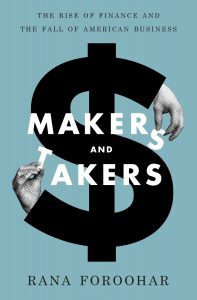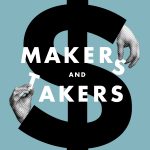 Every so often a book comes along that works its way into a majority of the interesting conversations you have with both friends and colleagues. Such is the case with Rana Foroohar’s Makers and Takers: The Rise of Finance and The Fall of American Business. Foroohar was kind enough to send me an early draft to read several months ago, and I found myself quoting from it in nearly everything I subsequently wrote, in every talk I gave, and even in various Slack channels at work. Makers and Takers is that rare work of journalism that both appears at a fortuitous moment in history, and captures the essence of that moment’s core narrative.
Every so often a book comes along that works its way into a majority of the interesting conversations you have with both friends and colleagues. Such is the case with Rana Foroohar’s Makers and Takers: The Rise of Finance and The Fall of American Business. Foroohar was kind enough to send me an early draft to read several months ago, and I found myself quoting from it in nearly everything I subsequently wrote, in every talk I gave, and even in various Slack channels at work. Makers and Takers is that rare work of journalism that both appears at a fortuitous moment in history, and captures the essence of that moment’s core narrative.
 Foroohar chronicles the rise of the financial industry and its destructive impact on the global economy. And she has the credibility and the chops to pull it off — over the past 15 years she’s covered the financial industry for Newsweek and Time. She’s been the global economic analyst for CNN for the past three years as well. Foroohar is not only passionate and opinionated about her field of work, she’s a lucid and compelling spokesperson for change in not only finance, but also in the purpose-driving business, and the social compact that binds us all as citizens in a global economy.
Foroohar chronicles the rise of the financial industry and its destructive impact on the global economy. And she has the credibility and the chops to pull it off — over the past 15 years she’s covered the financial industry for Newsweek and Time. She’s been the global economic analyst for CNN for the past three years as well. Foroohar is not only passionate and opinionated about her field of work, she’s a lucid and compelling spokesperson for change in not only finance, but also in the purpose-driving business, and the social compact that binds us all as citizens in a global economy.
Get Evonomics in your inbox
When people at a cocktail party hear you have a new book coming out and ask “What’s it about?” — what’s your answer?
My elevator pitch? We all know something is deeply broken in our economy. It’s been eight years since the financial crisis. The Fed has pumped $4 trillion of money into the markets, but we are still in the longest, slowest recovery of the post‑war era.
I believe that the reason for that is that our system of market capitalism is broken. The capital markets and Wall Street are no longer serving business or the Main Street economy that you and I live in.
If you think about it, capitalism as defined by Adam Smith was a system by which the capital markets would take the deposits that you and I put in the bank, and invest it in real businesses that create real jobs and growth.
But only 15 percent of all the money flowing through financial institutions today ends up in businesses. The rest of it is staying within the closed loop of the market itself. It’s being traded.
What is the rest of the money — that 85 percent — actually doing?
A lot of that money is going into the real estate market. Some of it is going to average people like you and me for mortgage loans, but the real money is in securitizing those loans.
We heard about that during the financial crisis, the splice‑and‑dice CDOs that blew up. That’s still happening. The mortgage market essentially funds the purchase of old assets, houses. It doesn’t grow the economy. That’s one part of it.
The other part of it is the securities market. The securities market is stocks, bonds, collateralized debt obligations and so on. They’re all the things on paper that the financial system trades in a closed loop.
Again, those are assets that are not creating real growth. In the last few years, you’ve seen this disconnect with the stock market at record highs, and yet income growth being flat, and overall GDP growth being flat.
Markets now create these asset bubbles, but the money going into new businesses — the hairdresser down the street, my dad starting a small manufacturing company in Indiana — that’s 15 percent of what comes out of financial institutions right now. That is totally a broken system.
When I ask people at large banks why they don’t lend more to business, they say it’s too risky. But isn’t securitizing assets, trading them up, and creating asset bubbles risky, too?
You’ve just hit at the existential problem in the financial sector, which has been brewing for 40 years. Yes, it’s really risky to start new businesses, and it’s risky to invest in them.
That’s what the financial system was set up to do, and one of the ways that it’s supposed to do it is by being rooted locally — the It’s a Wonderful Lifemodel of banking, where the banker actually knows you. They live in the same community. They take a few risky bets, and then they balance that out with less risky bets, and they also hold a lot more cash on their balance sheets than big banks do today.
One of the reasons that no big New York City banks went under during the Great Depression is that they were holding about 25 percent of their assets in cash. Banks today hold less than five percent in something called Cash or Cash Equivalents. That’s point number one.
Point number two is, yes, trading is really risky, but it’s also a lot more profitable than lending, and that’s why the securities industry has taken off exponentially, the amount of lending has decreased, and also bank deposits have decreased, as a percentage of what’s on the balance sheet.
The entire model has switched. Finance, as envisioned by Adam Smith, as it existed for the most part until the 1970s, was a helpmeet to business. It was not the main event. We have since gotten this idea that finance is somehow the natural highest point on Maslow’s hierarchy of the economy.
You’ve gotten 40 years of policy decisions that have encouraged that, that have protected this industry, and that’s one reason why this industry creates 4 percent of jobs and takes 25 percent of the corporate profit pie. That is just breathtaking. If you need one number to sum up where the problem is, it’s that.
You open your book with a story about Apple. Can you give us a sense of what’s surprising about how Apple runs its business?
Apple is certainly not unique, but it is one of the most successful companies in history. It exemplifies just how Kafka-esque the capital markets have become. Apple is holding more than $200 billion worth of cash, a lot of it in offshore tax havens.
It’s obviously cheaper to keep it there than to bring it back and pay US taxes. That’s the reason — even as they have all this cash — that Apple has been raising billions of debt at very low interest rates — rates that are also the result of the financial crisis. That’s a lot cheaper than bringing cash back abroad.
Why are they issuing this debt? Because they want to do stock buybacks, and pay out dividends to investors. Why do they want to do that? Because it artificially raises the price of its stock.
That’s one of the reasons that you’ve seen people like Carl Icahn tweeting that Apple should give back more and more money, do more and more share buybacks. Investors love that because it always jacks the share price up. Every time Icahn tweets, Apple’s share price goes up.
Why does Apple need to keep their share price up? I would argue that they haven’t really had a game‑changing, underlying technological innovation since Steve Jobs died. Ultimately, in the long run, a company’s success is tied to its real innovations.
In lieu of innovation and real engineering, Tim Cook has been executing financial engineering. We have a market system that is really serving investors, rather than anybody else — consumers, workers, the real economy. It’s a bizarro world.
Share buybacks were actually illegal in the early ’80s.
Yes, that’s right. Until 1982, it was considered market manipulation. It’s amazing that something that used to be illegal is now basically the status quo for corporate behavior. Share options — which push CEOs to think short term — make up somewhere between 30 and 80 percent of how the C‑Suite in America gets paid. It creates a cycle where they have every incentive to jack up share price in the short term.
Later in the book, you describe what happened to companies like GE and GM. It strikes me that Apple is potentially on the same cycle as those two companies.
Definitely. Once a company enters the public markets, things get a lot harder. There’s Stanford research showing that underlying innovation, tech development, R&D, tails off by about 40 percent once a company goes public.
That’s because, boom, you suddenly have pressure from the markets. Those can manifest in different ways. I got interested in GM when they were having their ignition switch crisis. It came to light that there had been a longstanding problem, where literally one division of the company wasn’t talking to the other, in terms of how the product was being engineered.
I spoke to Bob Lutz, who’s the former Vice Chairman of GM. He told me something really interesting. His book Car Guys Versus Bean Counters was basically about the culture of engineering versus the culture of finance. Lutz said, “This is a problem that goes all the way back to the Whiz Kids, to Robert McNamara, to what happened at Ford Motors.”
I started digging into this. What I found was fascinating. Indeed there was a period in time exemplified by Robert McNamara, who unsuccessfully led the Vietnam War effort, in which the Pentagon decided that they could come up with a metric for everything to win the war, and lost sight of how screwed up the overall mission was.
He brought that same sort of checking the box, CFO‑type thinking to Ford, and later to a number of other companies, including GM. His disciples went out into much of corporate America.
That led to people looking at organizations within silos, rather than looking at underlying mission, the technology, the innovations that are really driving our economy. It’s the opposite of Steve Jobs.
The bean counters made a number of decisions at GM that led to the ignition switch crisis. They stopped thinking about “How do we create the best products, and how do we serve our consumers?” That ended in tragedy. It’s something Mary Barra, the new CEO of GM, who happens to be an engineer, is trying very hard to rectify.
GE is in some ways America’s original innovator. Thomas Edison founded the company. It brought us an incredible number of innovations in the first half of the 20th century. Later on, Jack Welch — Neutron Jack, who laid off about 200,000 people — decided that finance was the business to be in.
In some ways, if you’re looking only at a balance sheet, it makes sense. Finance has incredible profit margins, relative to any other industry. He started switching GE from being a maker of new products and ideas into being a financier.
If the purpose of a company is to maximize shareholder return, the true north of the Friedman Chicago School, it strikes me that only a crisis like the ignition switch fiasco will drive a company to realize that it has to change its core purpose.
I think that’s right. I would say the contrast between Exxon and BP is an interesting one in that respect. Early in the financialization era, in 1989, Exxon had a huge crisis — the Exxon Valdez — and it really shifted its culture of risk.
BP didn’t have that crisis. It kept taking on a lot of risks, including in the financial sphere, which ended with trading disasters, and then it had the Deepwater Horizon disaster. Crisis sometimes is what’s required to change to things.
It seems amply evident that the right thing to do is to focus your company on the business of business, and not the business of financialization. However, all of the incentives, and all of the policy, seem to be pushing companies in the opposite direction. It’s almost as if you can’t blame them for doing what they do, because that’s how they’re being incented.
Right. One of the things I wanted to do in this book was get away from a culture of blaming the bankers, blaming the CEOs, blaming the one percent. I cover these people on a daily basis. Nobody’s venal here. They really are doing what they’re incentivized to do. It’s just that over the long haul, it doesn’t happen to work.
One of the most telling statistics that I came across in researching the book was a difference in how much investment a company made in CapEx, R&D, factories, and in worker training when you compared private companies with similar public ones. The private companies made twice the investments into the real economy as public companies did.
To me, that blows out of the water all of these arguments that large corporations and business lobbyists make about taxation and regulation. “Oh, if only the tax rates were so much lower, we would invest,” or, “Oh, if only this or that red tape was different.”
Private companies are out there investing under the same tax and regulatory frameworks. They see plenty of opportunities. But the public markets make it impossible for CEOs to take these long-term decisions. It’s interesting to track the public companies who buck this trend. Like Howard Schultz at Starbucks, who says “I’m going to offer health care for every employee,” or “I’m going to pay for every employee to get a college degree.” He’s only able to do that because he’s got a cult of personality — coupled with being an owner/founder who still has a big stake in the company. Jack Ma from Alibaba has explicitly said his corporate mandate is “to serve our company and our workers first, our customers second, and shareholders third.”
Are there rigorous defenders of the status quo? There weren’t a lot of people arguing with you and your ideas in the book itself. Is that because the people don’t want to talk, or is it because there aren’t actual rigorous arguments?
For the last couple of decades, it’s been really hard to find evidence that trickle‑down economics is working. The Chicago School, free market, laissez‑faire way of thinking has taken a big hit.
You can see it with the implosion of the Republican Party. They’re struggling for a resonant economic message. The Democrats are struggling, too. The more centrist Democrats, like Bill Clinton, bought into trickle‑down. Hillary is still trying to square that circle. The next president is going to have to deal with it.
It’s a growth issue. I get calls from hedge funds saying, “This is really interesting. You’re making a really compelling case that financialization is actually going to cause long term slower growth.”
That hurts their business models, because ultimately, at the end of the day, everything does eventually come back to what happens on Main Street. In an advanced economy that is 70 percent consumer spending, you cannot have growth when the average American hasn’t gotten a raise in real terms since the early ‘90s.
The blue collar workers that are causing this crazy political cycle right now haven’t gotten them since 1968. No wonder they’re in favor of Donald Trump.
Yet the argument of smaller government, less regulation seems to still be winning the day. When you pull back, isn’t this really a question of how do we wish to govern ourselves?
Yes, and bringing those two points together, it’s really about acknowledging that the corporate social compact of the post‑war era is at an end. It’s been frayed for some time. I think we can say that it’s been totally Uber-ized.
The way in which we work, who pays for the social safety net, at a time when there’s more government debt than ever, and more corporate profit than ever, the effects of technology in disrupting jobs, all of that is in the mix here.
The old model is broken. We need a new one. There isn’t really a silver bullet. One of the things that we can certainly start with is the tax code, and what it is subsidizing and incentivizing, and what it isn’t.
You used the term “Uber-ized.” I’m curious about that analogy. Is there something about Uber that reminds you of the larger theme of your book?
Yes. Think about a pie chart that has government and the public sector as one portion, and the corporation as another, and labor as the third. That’s essentially the economy. The corporate slice of that pie has been growing and growing for some time. In some way, Uber represents the apex of this.
The privatization, and therefore the financialization, of our public sphere?
Yes. Uber employs very few people. They have a lot of outside contractors. But the company is owned by a very few. There’s a huge amount of wealth being concentrated in fewer and fewer hands.
I think this cycle of financialization has reached a tipping point, where the system starts to break. Uber is causing a lot of conversations in Washington, in the Valley, all over America — asking “What is the purpose of a company? What are companies here to do?”
I did a profile of Travis Kalanick for Time. I sat in a fascinating meeting where he spoke to drivers. They had obviously been hand‑picked. But they started asking uncomfortable questions, like, “Well, when you go public …will we get a piece of this wealth?” He didn’t have good answers for them.
At the heart of this is something important. Where does the wealth in a company go? Is it just for the C‑Suite? Is it just for the shareholders? What about the broader community? Can you have an economy that is fundamentally stable if you have that bifurcation of wealth and distribution?
A lot of people in the Valley are uncomfortable with Uber, not for the obvious reasons, but because you just don’t question the success of a company like Uber. The goal is to create a company that’s a world‑beater. Uber has hit that goal. It’s what Google was in early 2000 or Facebook in 2010. No one wants to question a company like that. Given the theme of your book, do you think Uber is a taker or a maker?
A taker. I’m not saying that there’s not some innovation here, but this is software that has enriched a very few number of people. I’m not saying that everybody at Uber is bad, but its model doesn’t support an economy that’s made up 70 percent of consumer spending.
This isn’t all Uber’s fault. If I were Travis Kalanick, and I was thinking, “Well, maybe I could give stock options to every driver in America and in the world,” then suddenly, you’ve probably got employees instead of contractors.
Then you’ve got lots of other responsibilities. That gets into how governments regulate companies. What is expected of companies and why?
It used to be tech companies went public early. Microsoft went public at a market cap of around $750 million. Lots of investors rode Microsoft all the way up. But when Uber goes public, it will probably be valued at over $100 billion, if not $150 billion, just like Facebook was.
A small number of shareholders are going to make a lot of money. The ones who buy after the IPO could become the equivalent of the greater fool. It also used to be that an obscenely profitable company would be taxed, and that money would be redistributed through the government. But now nearly all successful companies hide their profits overseas. And raising taxes isn’t a way to win over voters.
It seems we won’t trust the government to redistribute wealth. And we can’t trust the financiers. And surveys show we also don’t trust the corporate chiefs. Who do we trust?
Government’s not popular, and neither are corporations. Corporations can float 35,000 feet above all these problems, all these issues of inequality and slow growth we’re now grappling with.
But ultimately, there is pushback, and it happens in countries — at the national level. You’re seeing it in populism, not just in the US, but all over. Look at France. Look at Germany. Look at the possibility of the UK pulling out of the Eurozone and rising nationalism in China. This is all a part of having a system of market capitalism that works at a global level, but governments are still national. That’s where the action is. Countries still govern. They can make corporations do things.
You said there’s no silver bullets — but what are rational steps we can take?
Bringing more people into the conversation is crucial. Right now, the way that market capitalism is structured, the way that corporations get regulated, most of that is a conversation had amongst elites.
That’s a problem. There are surveys showing that elites trust each other more than ever before, but the mass populations in every single country trust the elites less than ever before. That reminds me of pre‑revolutionary France.
So let’s bring more people into this discussion at every level. Companies can do that — look at what Starbucks did with race, for example. Local governments are already doing that. The kind of public/private conversation about what the new social compact should be is already happening in a lot of cities. It’s just not happening at a federal level.
The next president is going to have to grapple with the fact that we are at a turning point similar to where we were in the 1970s, where the paradigm changed towards a more laissez‑faire, free market, Reaganesque model. We know that model is broken now. We need a new one. If we get another four years of the same, I can guarantee you that we will have the same kind of election cycle in 2020 that we’re getting right now.
The next Bernie is going to be sharper and more electable, and the next Trump, who knows, might be even scarier.
When you said how the elites trust each other more, and the mass population trusts the elites less and less, it strikes me that explains Donald Trump in nutshell. He is an elite that the masses can trust — because he’s an outsider to most elites. The elites actually rejected him.
That’s why everybody missed how far he was going to go, and they may still be missing how far he can go.
Maybe we just need to take our medicine and make this guy president.
He’s like the Exxon Valdez of politics.
Is there any hope of us getting out of this financialized mess?
Even though all these things we’ve discussed seem really big and weighty, and they make you a little tired, and a little depressed, I would just say market capitalism is not a system that was handed down in perfect form from the heavens on stone tablets.
We made up these rules, and we can change them. It won’t happen overnight, but we can start the process. There are lots of companies that are starting the process. There are lots of really smart politicians that want to have a real conversation about this stuff.
Increasingly, empowered by technology, there are citizens that are just sharper than ever and want to talk about these issues. I’m hopeful in that sense. In that way, this election cycle, and how disruptive it’s been, actually makes me hopeful that we’re at a change point.
Originally published by NewCo Shift. Join their newsletter today.
2016 June 15
Donating = Changing Economics. And Changing the World.
Evonomics is free, it’s a labor of love, and it's an expense. We spend hundreds of hours and lots of dollars each month creating, curating, and promoting content that drives the next evolution of economics. If you're like us — if you think there’s a key leverage point here for making the world a better place — please consider donating. We’ll use your donation to deliver even more game-changing content, and to spread the word about that content to influential thinkers far and wide.
MONTHLY DONATION
$3 / month
$7 / month
$10 / month
$25 / month
You can also become a one-time patron with a single donation in any amount.
If you liked this article, you'll also like these other Evonomics articles...
BE INVOLVED
We welcome you to take part in the next evolution of economics. Sign up now to be kept in the loop!

























